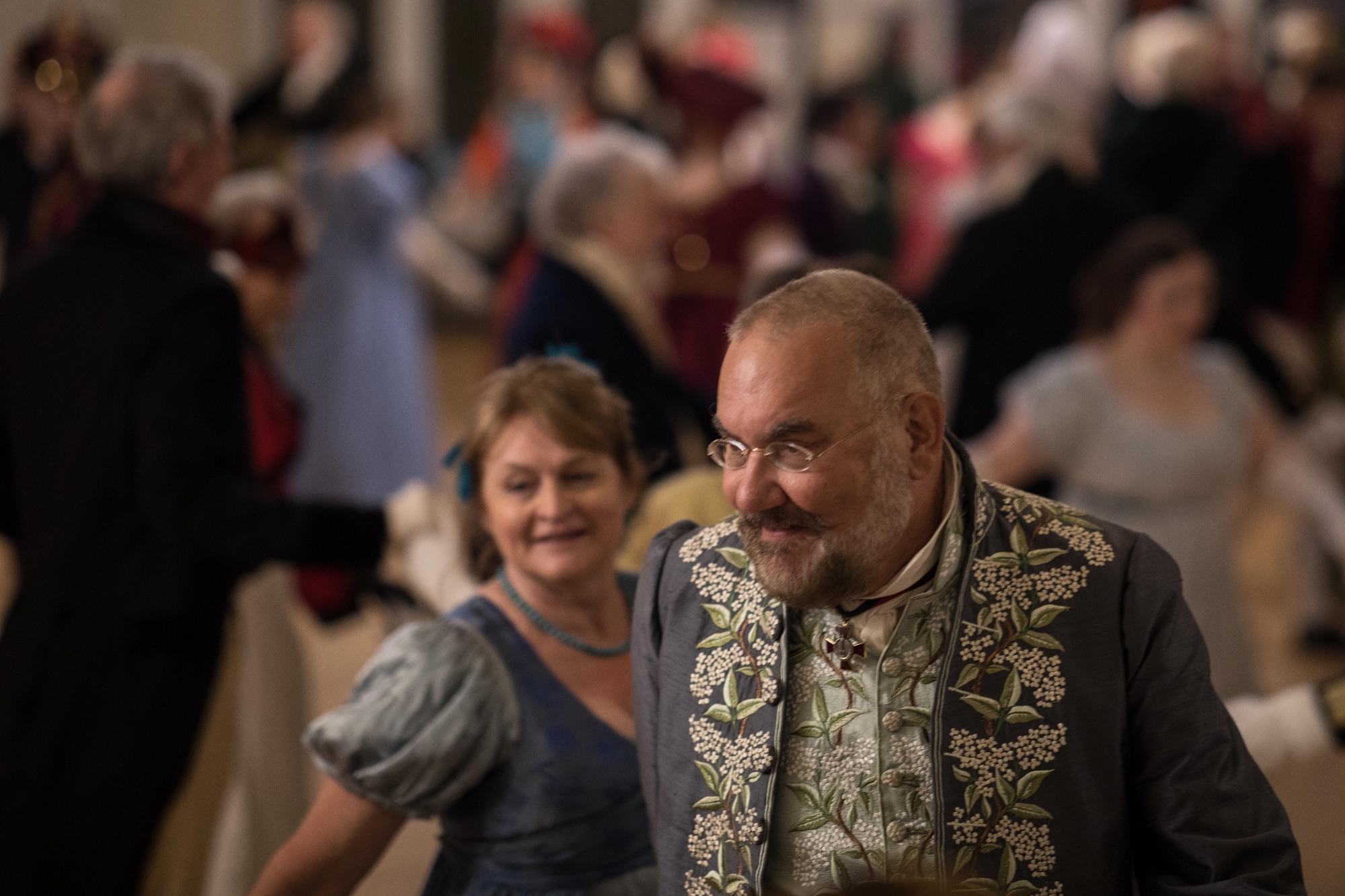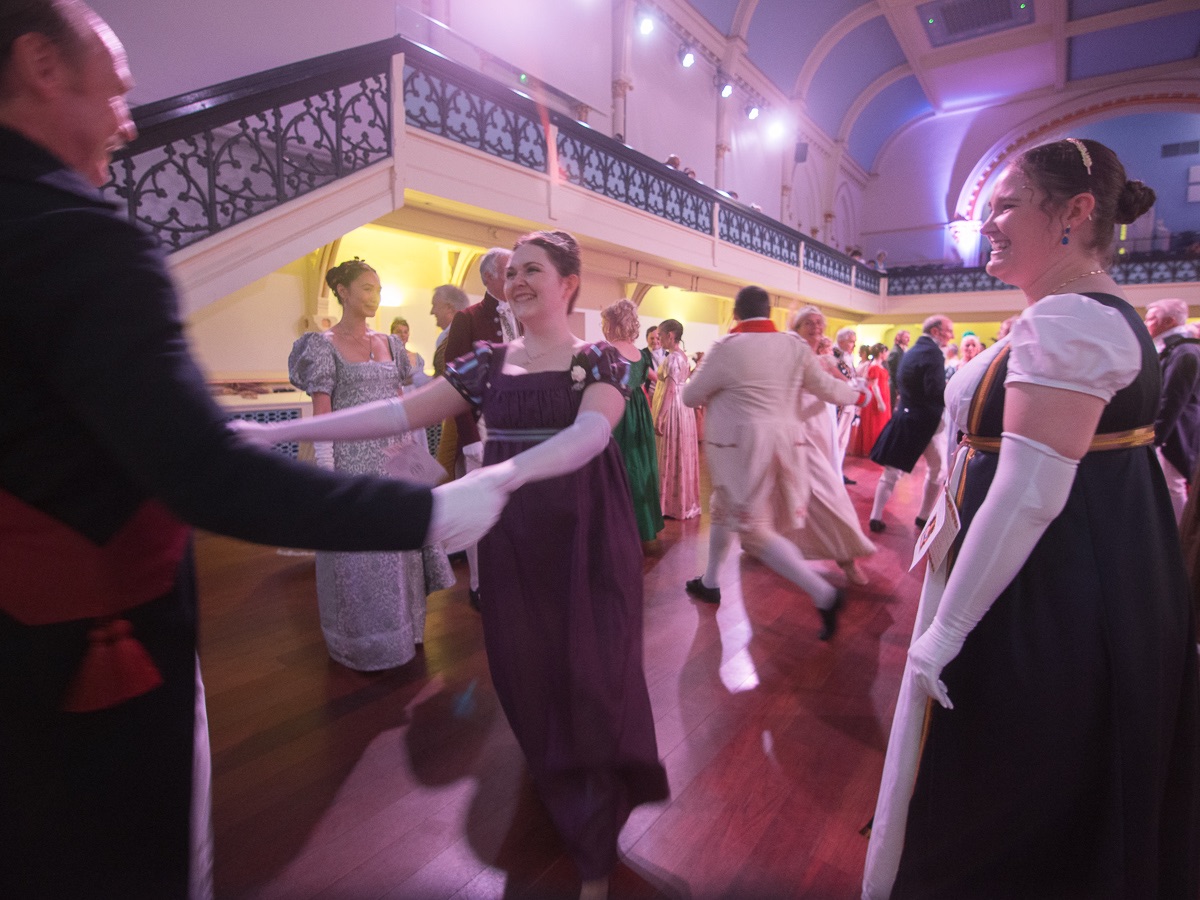Dancing Glossary
Brief intro about the page. If you would prefer to view the dancing calls glossary via downloadable pdf, the file is available here.
Lady / dame
Genteman / monsieur
Honours (less often called Reverence, usually for earlier dances)
Curtsey for lady and bow for man - to ones partner at the beginning and end of the dance. Be alert! Sometimes the music will just jump in with no time for honours given, the caller will let you know.
Honours (Lady)
Step sideways, closing in first position, bend both knees with back straight. Look at partner on commencing honour, then lower eyes until completed. Not exaggerated or too deep.
Honours (Gent)
Step sideways to third position, and bow from the waist (i.e. keep hips on the vertical), close foot behind. Look at partner on commencing honour, then lower eyes until completed. Not exaggerated or too deep.
Left / Gauche
e.g. moulinet right. Dancers will extend their right hands to perform the move physiognomy dictates that they will dance clockwise.
Right / Droit
e.g. moulinet left. The left hand will be extended which dictates that the circle will be danced anti-clockwise.
Circle / Rond / Grand Rond
Persons identified by the caller join hands and dance in a circle. Grand Rond means all the dancers in the set dance in a circle.
Allemande turn (right)
Standing sideways to partner, extend your right arm to behind your partner's back (linking elbows) to hold the hand waiting there, while at the same time putting your left arm behind your own back to receive your partner's extended hand. Turn around each other - maintaining eye contact.
Allemande turn (left)
Standing sideways to partner, extend your left arm to behind your partner's back (linking elbows) to hold the hand waiting there, while at the same time putting your right arm behind your own back to receive your partner's extended hand. Turn around each other - maintaining eye contact.
The line
Usually the dancers who are standing side by side with each other. This is usually down one side of a longways set or one side of a three couple set.
Star / Moulinet
Circular move in which the dancers link hands in the centre and dance round. Usually in a group of four. Take the hand of your diagonal, not bunching all hands together. 1st gentleman and 2nd lady have their hands above the other two.
Chassé Croisé
Sideways steps. Facing into the set, the lady always dances crossing in front of the gentleman, he dancing to the right and she to the left, as they dance in opposite directions of each other. They then usually (but not always) dance back into their original positions. When facing each other, they dance out to their respective rights and back to face each other again.
From the HRD masterclass, we have a video available for the Chassé Croisé:
Jeté
A small spring forward from one foot, landing lightly on the toe of the other.
Grand chaine
Starting with partner by right hand, dance in a large circle round the set, turning each dancer you meet in a single hand half turn alternating hands and direction of turn as you go round. The dancer's overall path should be a sinuous line of half circles.
Assemblé
Small jump in which the back foot is brought round to the front and the dancer lands on both feet in third position often associated with a jeté immediately beforehand.
Tems Levé
Brief hop on one leg with no transfer of weight often as the other leg is being raised and extended. e.g. At the start of a move.
Balance / Balancez
A step to the side transferring weight onto the other foot and then sideways back again. The exact movement depends upon the step and music timing used.
Set
A movement on the spot - small hop onto right foot with left foot following, transfer weight briefly to left foot and then back to right. Repeat in the opposite direction.
Hey
There are various forms - this is the essential to know. Most usual is in the line of three. Top dancer (no. 1) looks down the set, the other two (no. 2 and no. 3) look up. They weave amongst themselves, essentially tracing a figure of 8 on the floor.
Cross hey
A specified dancer crosses to the other side of the set and performs a hey with the opposite side dancers and returns to place.
Mirror hey / Grimstock hey
Both sides of the set hey at the same time with partners alternately coming together to go between or parting to go outside a couple coming in the opposite direction - in at the middle, out at the ends. In the Grimstock hey partners join hands whenever they meet, in mirror they do not.
Ladies hey / ladies chain
Usually in a square dance. Ladies move into the centre of the set and half left moulinet so as to move towards the opposite position. They are received by the man waiting there (having moved sideways into his partner's place) who right hand turns her to go back into the middle. Ladies return to the middle where they half moulinet left to return to their own side. They are received by their own partner who right hand turns them both into place.
Foot it - back step
Hop on left foot, passing right foot behind.
Foot it - Single
Hop on left foot, passing right behind, then make a gentle spring sideways left on left foot, closing right foot behind (one bar).
Foot it - Double
Hop on left foot, passing right foot behind, then make a gentle spring sideways left on left foot, closing right foot behind. Then make two further springs on left foot, closing right foot behind.

Petronella
An anti-clockwise turn single during which the dancer moves from one line to another - usually to the adjacent side of the set on the left.
Poussette
Facing partner holding both hands, move up and down the set by pushing out and pulling back into line in a different place, usually going anti-clockwise - there are a number of types, the most common being ordinary poussette (effectively the couples do a dos á dos move) and drawn pousette (one partner leads and the other follows).
Hole in the Wall
Partners move towards each other meeting in the middle of the set, turning face to face and then moving on to occupy the place of the other.
Turn
Move with two dancers taking either one or two hands and making a small circle round each other. The caller may direct full turns or fractions of a turn as the dance requires. Direction of the turn is dictated by which hand is being used. Two hand turns go clockwise.
Turn single
Dancer turns alone either on the spot or in a small circle - men usually turn over their left shoulder and ladies over their right but this may vary if the dancer is facing out of the set.
Square hey / rights and lefts
In your set of four, a sequence where starting with your partner you dance across the set:
- Turn the person opposite you a quarter right turn.
- Turn the next person a quarter turn in the line.
- Cross the set again and turn the next dancer a quarter turn.
- Finally in the line the next person to end up back in place.
From the HRD Masterclass, we have a video on the steps for a Square Hey.
Tiroir
In a square dance inside the set, you dance with your opposites across the set as a couple and back again.
- One couple join hands and cross together while the other couple separate and cross the set outside the others.
- Both couples turn and reverse roles (inside and outside) to dance back to place.
Grand square / Grand carré
Heads link inside hands and take two steps forward, meeting in the middle. Take two hands with vis á vis and take two sideways steps out of the set. Drop hands and take two steps back, then two steps sideways back into position, each dancer having moved in their own square.
While this is being performed, the sides do the opposite. i.e. Moving sideways out of the set as the heads are going in, forwards to meet vis á vis as the heads are going out, sideways into the centre as the heads are going sideways on the outside, and then backwards to meet partner as the heads are coming in sideways to meet partner.
Often, the whole process is then repeated in reverse.
Heads
In Cotillion or Quadrille, the two couples faicing each other who are closest and furthest away from the top. E.g. north and south.
Sides
In Cotillion or Quadrille, the other two couples facing each other on the side. E.g. east and west.
Go down
Move away from the top of the set.
Go up
Move towards the top of the set.

Cross
Move from your place across the set towards the opposite line - if partners are crossing at the same time they usually pass by their right shoulder. Men give way to ladies.
Cast
Man turns over left shoulder, lady turns over right shoulder, and move down the outside of the set for however many positions may be directed. One can also cast up in which case the shoulder over which you turn is reversed. Dancers may cast individually or at the same time as may be directed.
Acknowledge
Engage eyes and slight inclination of the head - usually to your opposite (vis á vis)
Opposite / vis à vis
Person standing directly opposite you in a square set where your partner would be if you were standing there as a couple.
You may hear the following mentioned by a caller- these will best be covered in detail in our masterclass series of videos and so not covered here.
Drop step / Allemande step
A video from the HRD masterclass will be made available for this step.
Chassé step
From the HRD masterclass, we have a video available for the Chassé travelling step:
Fleuret / Pas de Bouré step
From the HRD masterclass, we have two videos available for the Fleuret step:
Waltz step
From the HRD masterclass, we have two videos available for the Waltz step:
Strathspey step
From the HRD masterclass, we have a video available for the Strathspey step:
Scottish / Schottishe
A video from the HRD masterclass will be made available for this step.
Long balance
A video from the HRD masterclass will be made available for this step.
Rigadon/rigaudon
From the HRD masterclass, we have a video available for the rigadon:
Balloté
A video from the HRD masterclass will be made available for this step.
Contretemps
A sequence of steps comprising part of the common quadrille forward & back combination - being a hop, step, close, step. It is often built into many sequences in quadrille and can be performed in any direction.
There are different ways of performing this but the version adopted by HRD is contained within the "Quadrille forward and back" video:

Notes
- All steps should be done on the half or three-quarter toe.
- All leaps or hops should land on the half or three-quarter toe, the heel then sinking gently and silently to the floor.
- Feet off the floor should have toes pointed.